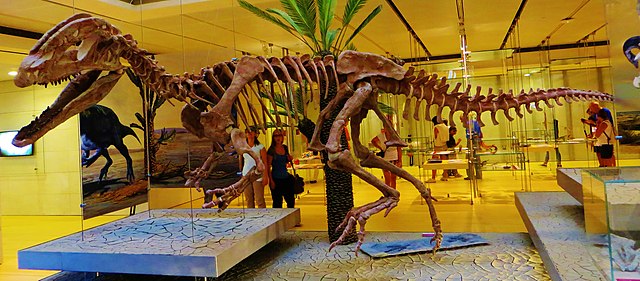Liliensternus is an extinct genus of basal neotheropod dinosaur that lived approximately 210 million years ago during the latter part of the Triassic Period in what is now Germany. Liliensternus was a moderate-sized, bipedal, ground-dwelling carnivore, that could grow up to 5.15 m (16.9 ft) long. It is the best represented Triassic theropod from Europe and one of the largest known.
Liliensternus
Liliensternus restored with a speculative crest.
Teeth assigned to Liliensternus sp.
Restoration of Liliensternus (foreground) in its environment, with Plateosaurus in the background
Dilophosaurus is a genus of theropod dinosaurs that lived in what is now North America during the Early Jurassic, about 186 million years ago. Three skeletons were discovered in northern Arizona in 1940, and the two best preserved were collected in 1942. The most complete specimen became the holotype of a new species in the genus Megalosaurus, named M. wetherilli by Samuel P. Welles in 1954. Welles found a larger skeleton belonging to the same species in 1964. Realizing it bore crests on its skull, he assigned the species to the new genus Dilophosaurus in 1970, as Dilophosaurus wetherilli. The genus name means "two-crested lizard", and the species name honors John Wetherill, a Navajo councilor. Further specimens have since been found, including an infant. Fossil footprints have also been attributed to the animal, including resting traces. Another species, Dilophosaurus sinensis from China, was named in 1993, but was later found to belong to the genus Sinosaurus.
Dilophosaurus
Reconstructed skeleton of Sinosaurus sinensis from China, originally described as a species of Dilophosaurus, Museo delle Scienze
Cast of Coelophysis, with which Dilophosaurus has often been grouped, Redpath Museum
Reconstructed skeleton of the crested Cryolophosaurus, sometimes considered a close relative of Dilophosaurus








